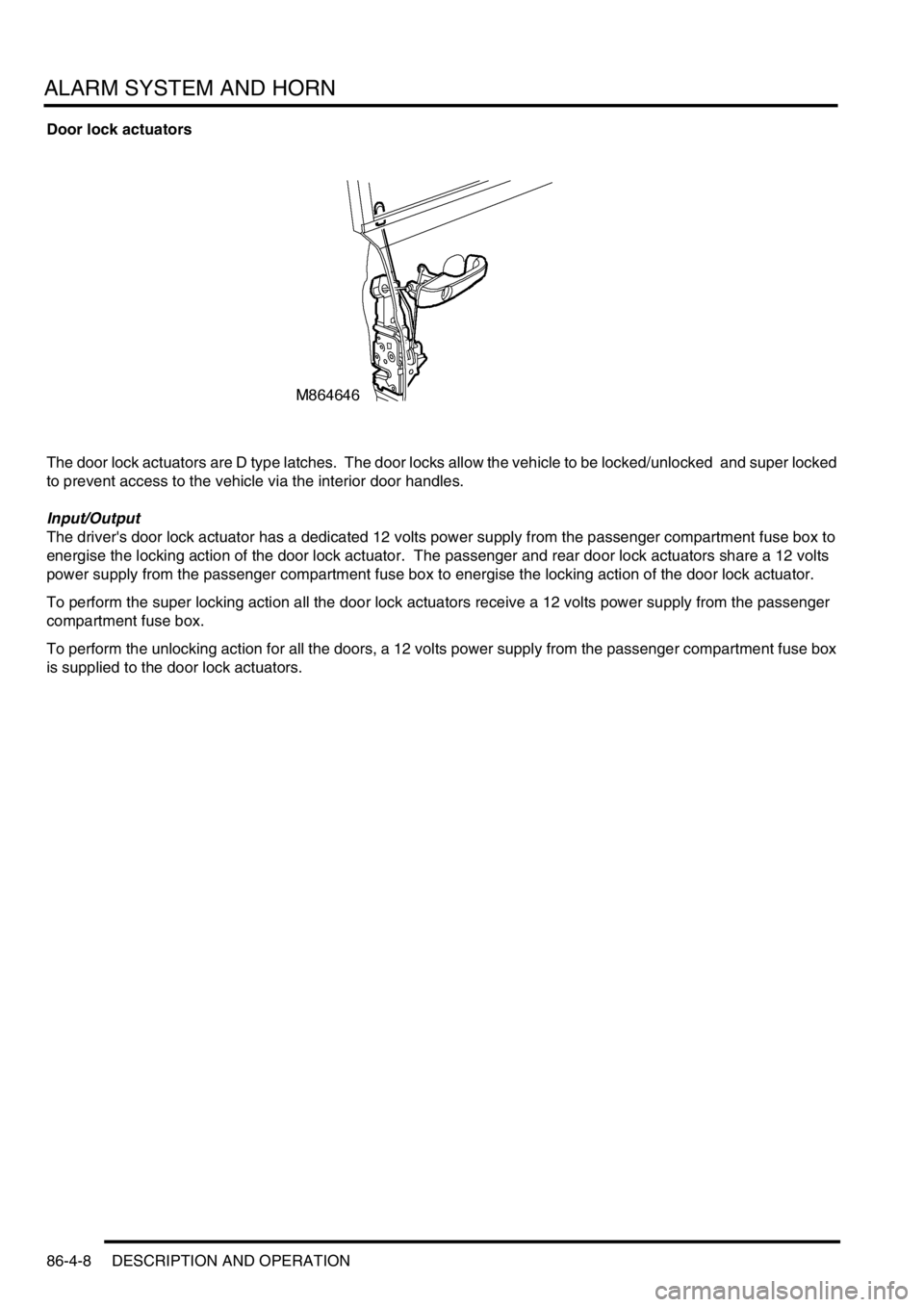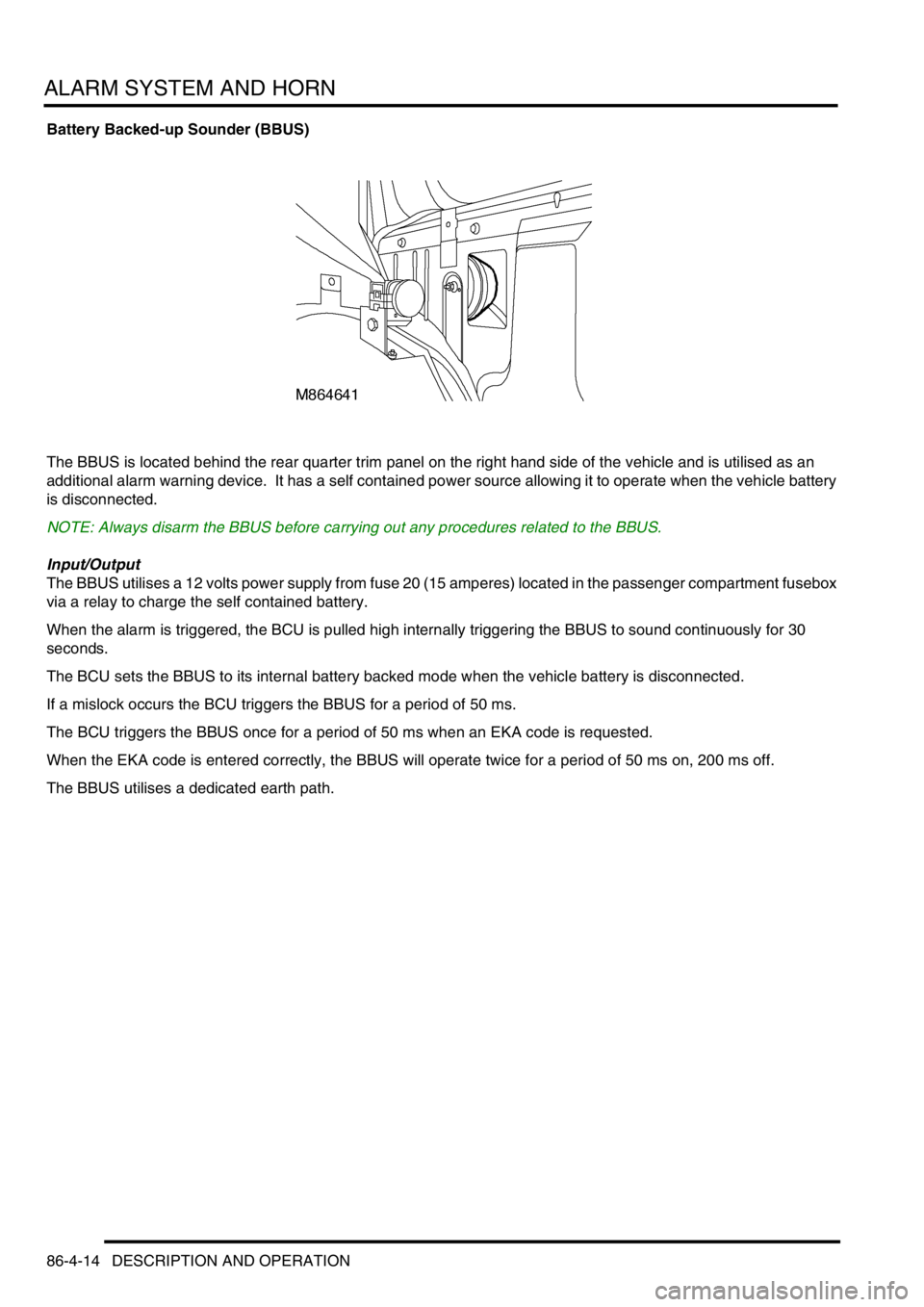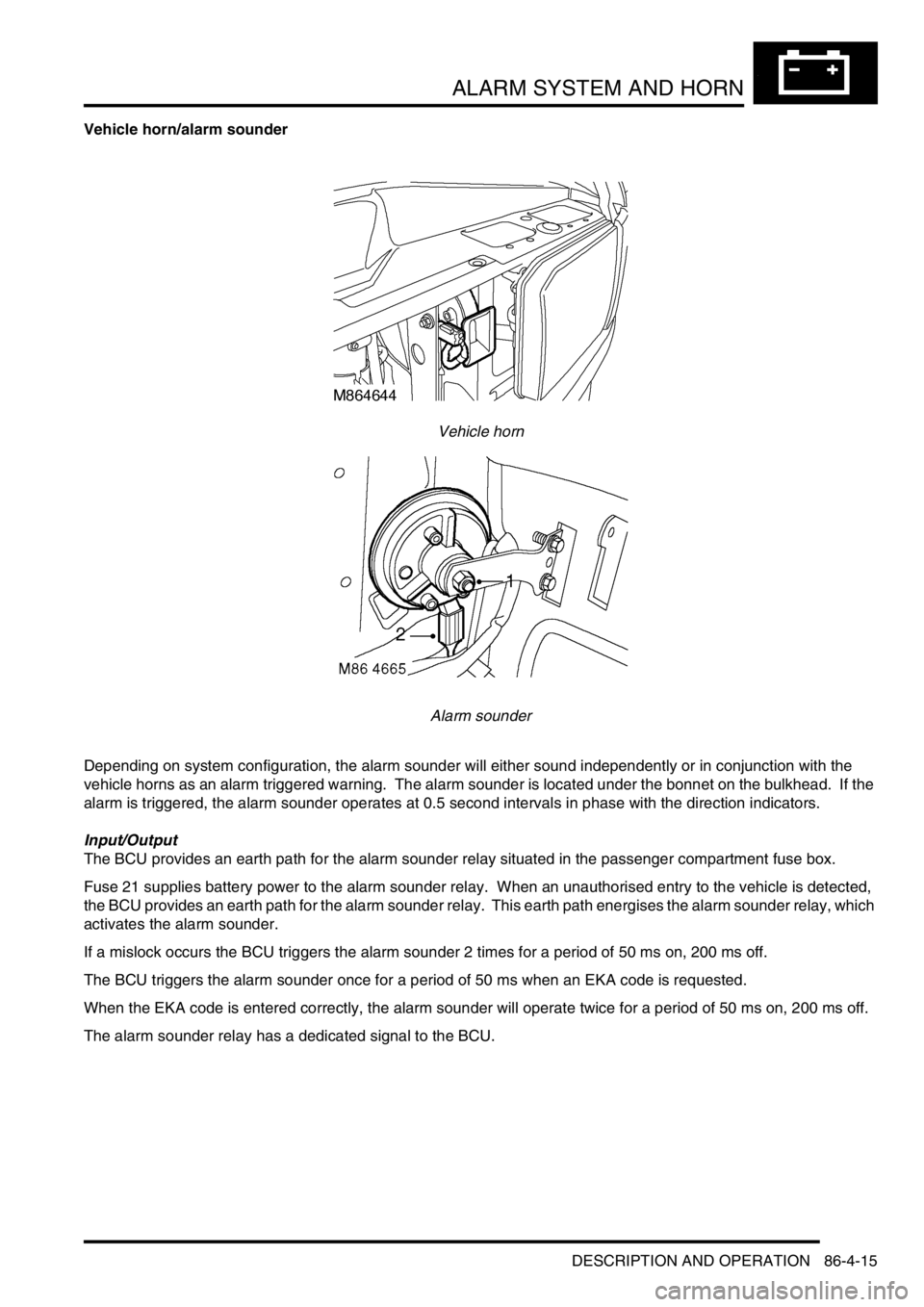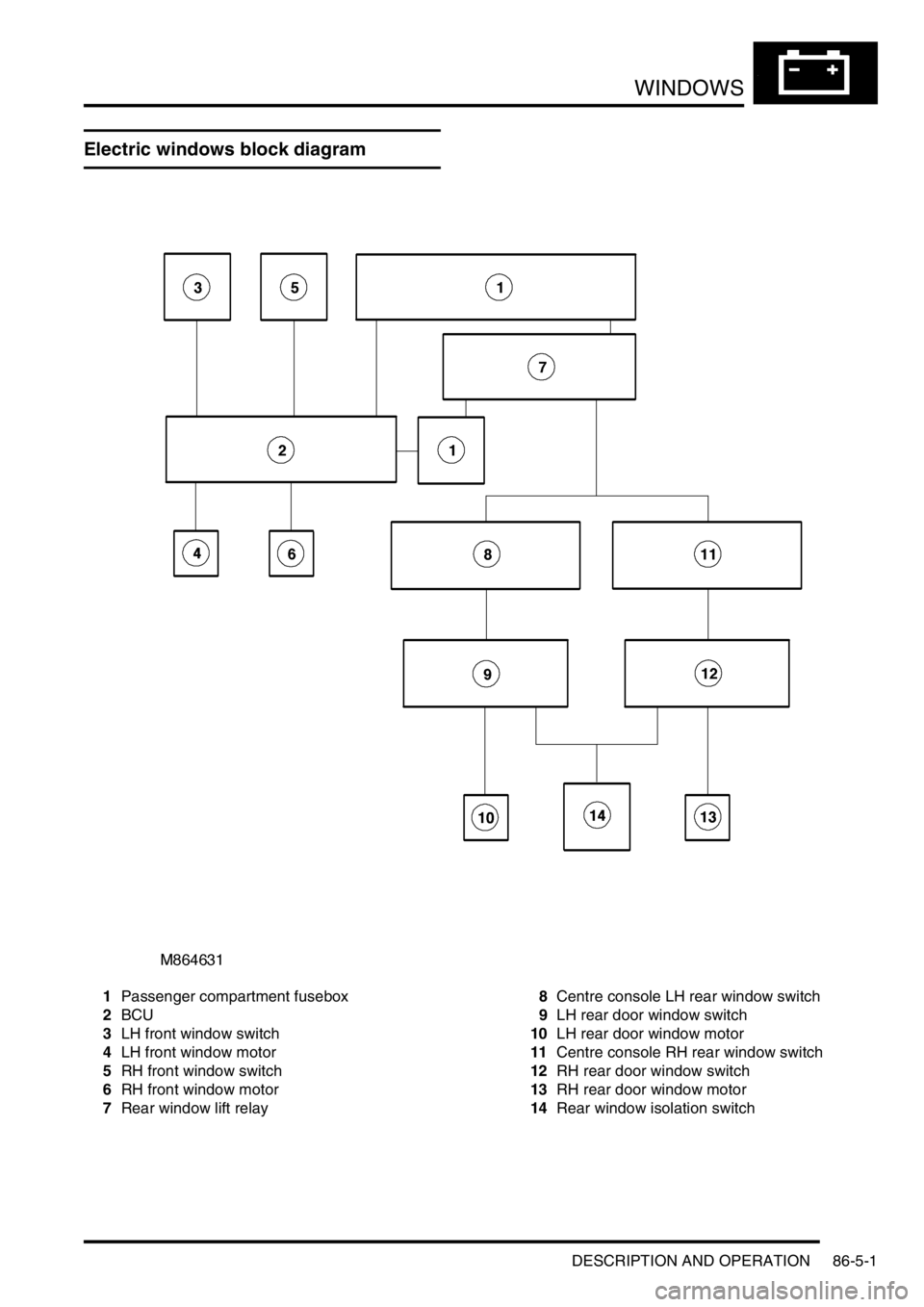1999 LAND ROVER DISCOVERY fuse box
[x] Cancel search: fuse boxPage 1316 of 1529

BODY CONTROL UNIT
DESCRIPTION AND OPERATION 86-3-29
Front fog lamps
Front fog lamp operation is monitored by the BCU, which allows only the front fog lamps to operate when the side
lamps or headlamps are on. When the side lamps, headlamps or ignition switch is turned off, the BCU also switches
off the fog lamps. When the side or headlamps are switched on again, the front fog lamps will remain off unless the
front fog lamp switch is pressed to resume operation. If the rear fog guard lamps are selected on, switching off the
front fog lamps will also switch off the rear fog guard lamps.
When the fog lamp switch is operated, an earth path is completed and the BCU allows the fog lights to be switched
on providing the logical preconditions have been satisfied. The BCU then supplies a voltage supply to the fog lamp
relay, to illuminate the fog lamps.
The front fog lamps option can be programmed in one of three states dependent on market/ customer requirements,
these are:
lOption 1– not fitted.
lOption 2 – main beam no effect.
lOption 3 – off with main beam.
The BCU checks the status of the following inputs to determine the logic action for providing an output to the front fog
lamp relay:
lIgnition state.
lMain beam state.
lSide lamps.
lDipped beam.
lFront fogs selected (press button, not latched).
If the ignition state is crank the state of the front fog relay is memorised and the relay is switched off. Pressing the
front fog switch during cranking will not be recognised. When the ignition state returns to Ignition after cranking, the
memorised front fog relay state is restored. If the ignition is turned off, the front fog relay is turned off.
For option 3 configuration, if the main beam is turned on the state of the front fog relay is memorised and the relay is
switched off. Pressing the front fog switch while main beam is on will not be recognised. When the Main beam state
returns to OFF, the memorised front fog relay state is restored.
In the event of a communications link failure while the front fog relay is on, the front fog relay will be switched off.
Rear fog lamps
The rear fog lamps operation is monitored by the BCU, which only allows the rear fog lamps to operate when the side
lamps or the headlamps are on. When the side lamps, headlamps or ignition is switched off, the rear fog lamps are
also switched off. When the side lamps or headlamps are switched on again, the rear fog lamps will not switch on
again unless reselected by operating the rear fog lamps switch. If front fog lamps are fitted, the rear fog lamps will be
switched off if the front fog lamps are switched off.
A supply voltage to the rear fog lamps relay is provided from a fuse in the passenger compartment fuse box, then
through two electronic switches in the IDM. With the lighting switch in the side lamp or headlamp position, an earth
path from the coil of the rear fog lamps relay completes the circuit through the two switches in the IDM to switch the
rear fog lamps on when the BCU receives a request signal from the rear fog lamps switch to turn the circuit on.
The BCU checks the status of the following inputs to determine the logic action for providing an output to the rear fog
lamp relay:
lIgnition state.
lMain beam state.
lDipped beam.
lFront fogs relay.
lRear fogs selected (press button, not latched).
If the ignition state is crank the state of the rear fog relay is memorised and the relay is switched off. Pressing the front
fog switch during cranking will not be recognised. When the ignition state returns to Ignition after cranking, the
memorised rear fog relay state is restored. If the ignition is turned off, the rear fog relay is turned off.
In the event of a communications link failure occurring while the rear fog relay is on, the rear fog relay will remain on
until the ignition is turned off or the dipped/ main beam is turned off.
Page 1328 of 1529

ALARM SYSTEM AND HORN
DESCRIPTION AND OPERATION 86-4-5
Description
General
The anti-theft system deters the theft of the vehicle with both active and passive systems. The active systems monitor
the vehicle perimeter and, in some markets the vehicle interior, for intrusion. If the system detects intrusion, an alarm
sounds. The passive systems include a vehicle immobiliser as well as protection against intrusion through super
locking the doors. The vehicle is immobilised whenever the ignition key is removed from the ignition switch. Super
locking prevents the interior door handles from opening the doors. In addition, there are many features and functions
that enhance system operation.
It is possible to perform the various functions associated with the anti-theft system remotely. To accomplish this, the
handset generates a radio frequency when the lock button or unlock button is depressed. This signal is transmitted
to the Body Control Unit (BCU) via a receiver located in front of rear sunroof beneath the headlining. Precise alignment
of the handset to the receiver is not necessary. The approximate operating range between the handset and the
receiver is 10 metres (33 feet).
It is important to understand the configuration of the system on each particular vehicle. There are many
different combinations of features with dedicated operating modes. System configuration for each vehicle
can be determined using TestBook.
The anti-theft system is controlled centrally by the BCU, which is located below and behind the passenger glovebox.
A serial communication link communicates between the Intelligent Driver Module (IDM) located within the fusebox,
the BCU and the LED located in the instrument panel.
The state of the alarm is stored in the BCU. If the battery is disconnected while the alarm is armed, the alarm will be
triggered when the battery is reconnected.
NOTE: Disconnecting the battery while the alarm is armed triggers the alarm. Always disarm the alarm system before
disconnecting the battery.
The BCU also receives inputs from the following components:
lIgnition key in sensor.
lIgnition switch.
lFuel cut off switch.
lFuel flap release switch.
The BCU also interacts with the following components:
lStarter relay.
lVehicle horns.
lDirection indicators.
lFuel flap release actuator.
lCourtesy lamps.
Page 1331 of 1529

ALARM SYSTEM AND HORN
86-4-8 DESCRIPTION AND OPERATION
Door lock actuators
The door lock actuators are D type latches. The door locks allow the vehicle to be locked/unlocked and super locked
to prevent access to the vehicle via the interior door handles.
Input/Output
The driver's door lock actuator has a dedicated 12 volts power supply from the passenger compartment fuse box to
energise the locking action of the door lock actuator. The passenger and rear door lock actuators share a 12 volts
power supply from the passenger compartment fuse box to energise the locking action of the door lock actuator.
To perform the super locking action all the door lock actuators receive a 12 volts power supply from the passenger
compartment fuse box.
To perform the unlocking action for all the doors, a 12 volts power supply from the passenger compartment fuse box
is supplied to the door lock actuators.
Page 1336 of 1529

ALARM SYSTEM AND HORN
DESCRIPTION AND OPERATION 86-4-13
Passive remobilisation exciter coil
The passive remobilisation exciter coil consists of a coil around the steering column lock. The coil energises to create
a magnetic field when the ignition is switched to position II.
This coil activates the handset initiating the mobilisation of the vehicle.
Input/Output
The input to the passive remobilisation exciter coil from the BCU is a 12 volts 125 kHz sinewave. The passive
remobilisation exciter coil also receives an ignition controlled power supply via fuse 20 (15 amperes) located in the
engine compartment fuse box. On receiving these signals, a magnetic field is generated which activates the handset
to produce a remobilisation signal. This remobilisation signal is transmitted to the remote receiver and onto the BCU
to allow the engine to start.
Page 1337 of 1529

ALARM SYSTEM AND HORN
86-4-14 DESCRIPTION AND OPERATION
Battery Backed-up Sounder (BBUS)
The BBUS is located behind the rear quarter trim panel on the right hand side of the vehicle and is utilised as an
additional alarm warning device. It has a self contained power source allowing it to operate when the vehicle battery
is disconnected.
NOTE: Always disarm the BBUS before carrying out any procedures related to the BBUS.
Input/Output
The BBUS utilises a 12 volts power supply from fuse 20 (15 amperes) located in the passenger compartment fusebox
via a relay to charge the self contained battery.
When the alarm is triggered, the BCU is pulled high internally triggering the BBUS to sound continuously for 30
seconds.
The BCU sets the BBUS to its internal battery backed mode when the vehicle battery is disconnected.
If a mislock occurs the BCU triggers the BBUS for a period of 50 ms.
The BCU triggers the BBUS once for a period of 50 ms when an EKA code is requested.
When the EKA code is entered correctly, the BBUS will operate twice for a period of 50 ms on, 200 ms off.
The BBUS utilises a dedicated earth path.
Page 1338 of 1529

ALARM SYSTEM AND HORN
DESCRIPTION AND OPERATION 86-4-15
Vehicle horn/alarm sounder
Vehicle horn
Alarm sounder
Depending on system configuration, the alarm sounder will either sound independently or in conjunction with the
vehicle horns as an alarm triggered warning. The alarm sounder is located under the bonnet on the bulkhead. If the
alarm is triggered, the alarm sounder operates at 0.5 second intervals in phase with the direction indicators.
Input/Output
The BCU provides an earth path for the alarm sounder relay situated in the passenger compartment fuse box.
Fuse 21 supplies battery power to the alarm sounder relay. When an unauthorised entry to the vehicle is detected,
the BCU provides an earth path for the alarm sounder relay. This earth path energises the alarm sounder relay, which
activates the alarm sounder.
If a mislock occurs the BCU triggers the alarm sounder 2 times for a period of 50 ms on, 200 ms off.
The BCU triggers the alarm sounder once for a period of 50 ms when an EKA code is requested.
When the EKA code is entered correctly, the alarm sounder will operate twice for a period of 50 ms on, 200 ms off.
The alarm sounder relay has a dedicated signal to the BCU.
Page 1354 of 1529

WINDOWS
DESCRIPTION AND OPERATION 86-5-1
WINDOWS DESCRIPTION AND OPERAT ION
Electric windows block diagram
1Passenger compartment fusebox
2BCU
3LH front window switch
4LH front window motor
5RH front window switch
6RH front window motor
7Rear window lift relay8Centre console LH rear window switch
9LH rear door window switch
10LH rear door window motor
11Centre console RH rear window switch
12RH rear door window switch
13RH rear door window motor
14Rear window isolation switch
Page 1356 of 1529

WINDOWS
DESCRIPTION AND OPERATION 86-5-3
1Passenger compartment fusebox
2Body Control Unit (BCU)
3LH front window switch
4LH front window motor
5RH front window switch
6RH front window motor
7Rear window lift relay
8Centre console LH rear window switch
9LH rear door window switch
10LH rear door window motor
11Centre console RH rear window switch
12RH rear door window switch
13RH rear door window motor
14Rear window isolation switch